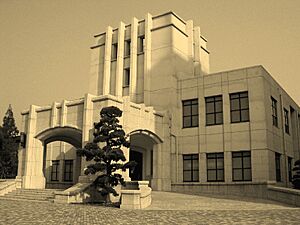Army Ministry facts for kids
| 陸軍省 Rikugun-shō |
|
 HQ building of the Imperial Japanese Army, Tokyo, from 1937–1945 |
|
| Agency overview | |
|---|---|
| Formed | April 1872 |
| Preceding |
|
| Dissolved | November 1945 |
| Superseding agency |
|
| Jurisdiction | |
The Army Ministry (known in Japanese as 陸軍省 (Rikugun-shō)) was a very important government office in the Empire of Japan. It was like a special department that managed all the everyday tasks for the Imperial Japanese Army (IJA). This ministry was active from 1872 until 1945.
Contents
What Was the Army Ministry?
The Army Ministry was set up in April 1872. It worked alongside the Navy Ministry. Their job was to take over from an older office called the Ministry of War.
At first, the Army Ministry handled everything for the army. This included both managing the army's daily needs and planning its military operations. But in 1878, a new office was created: the Imperial Japanese Army General Staff Office. After that, the Army Ministry focused only on administrative tasks.
Its main jobs included:
- Getting money for the army's budget.
- Buying weapons and supplies.
- Managing army personnel (soldiers and officers).
- Working with the Japanese parliament (the National Diet) and the Cabinet.
- Dealing with general military policies.
How Powerful Was the Army Minister?
The person in charge of the Army Ministry, called the Army Minister, had a lot of power. Even though they were part of the Cabinet (the group of top government officials), the Army Minister answered directly to the Emperor. The Emperor was the supreme commander of all Japanese armed forces. This meant the Army Minister did not have to report to the Prime Minister.
From 1900, a special law said that the Army Minister had to be an active general in the Imperial Japanese Army. This rule was put in place to stop political parties from having too much say in military matters. This law was removed for a while but brought back in 1936.
This rule gave the army a lot of control. If the army didn't like a government, they could refuse to nominate a general to be the Army Minister. Without an Army Minister, a government could not be formed or continue. This was a big reason why representative democracy in Japan weakened and Japanese militarism grew stronger.
After 1937, both the Army Minister and the Chief of the Army General Staff were part of the Imperial General Headquarters. This was the highest command center for the military.
The Army Ministry was shut down in November 1945. This happened after Japan surrendered at the end of World War II. The Allied forces, led by the Supreme Commander for the Allied Powers, abolished it along with the Imperial Japanese Army. It was not brought back in Japan's new constitution after the war.
How Was the Army Ministry Organized?
The Army Ministry had several departments that handled different tasks. These included:
- Under-Secretary of the Army (the Vice Minister)
- Military Affairs Bureau
- Personnel Bureau
- Weapons Bureau
- Army Service Bureau
- Administration Bureau
- Intendance (which handled accounts and supplies)
- Medical Bureau
- Judicial Bureau
- Economic Mobilization Bureau (which was later abolished)
- Aeronautical Department
The main offices for the Army Ministry and the Imperial General Headquarters were in a place called Ichigaya Heights. This area is now part of Shinjuku, a district in Tokyo.
See also
- Imperial Japanese Army General Staff Office
Images for kids





























